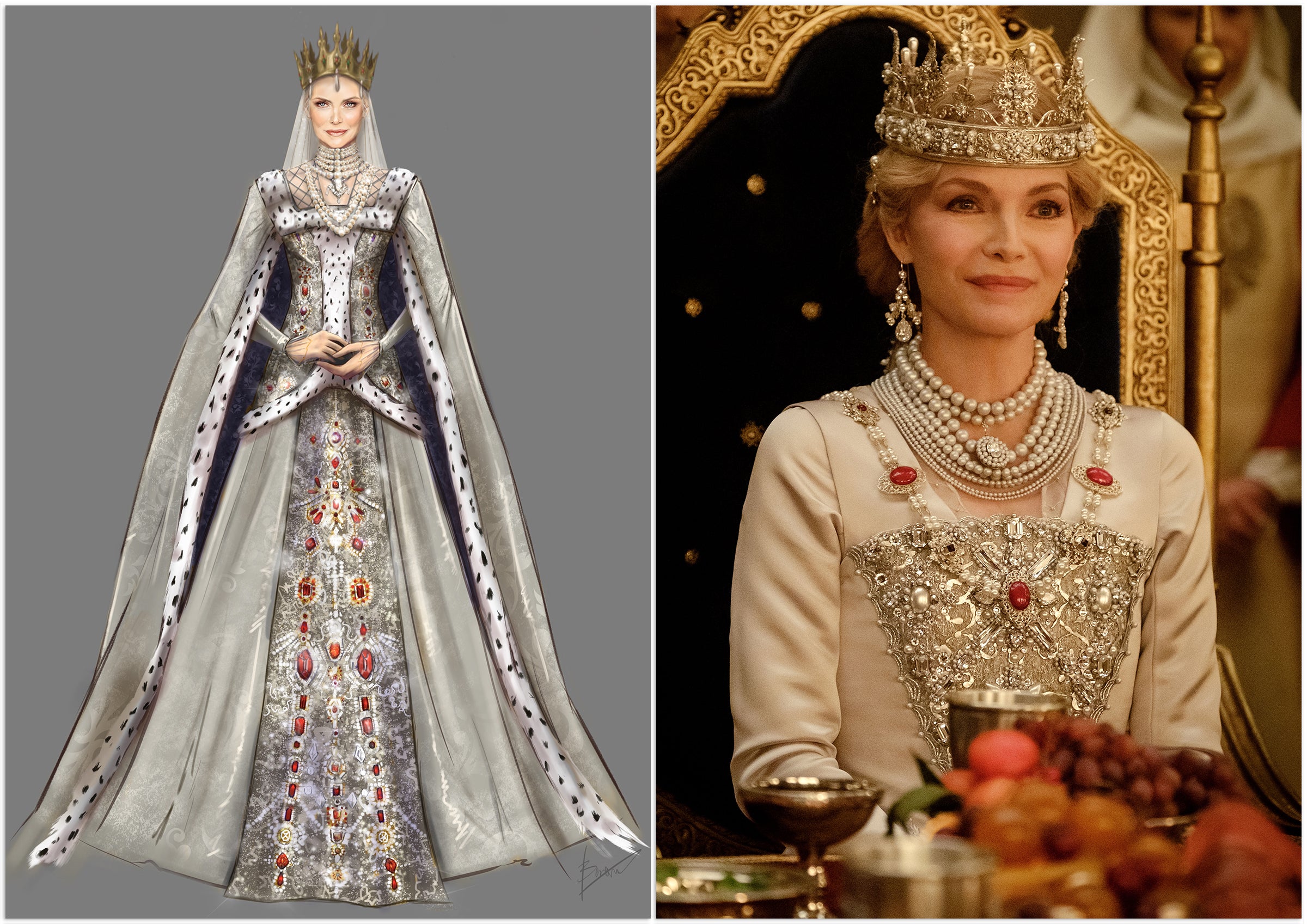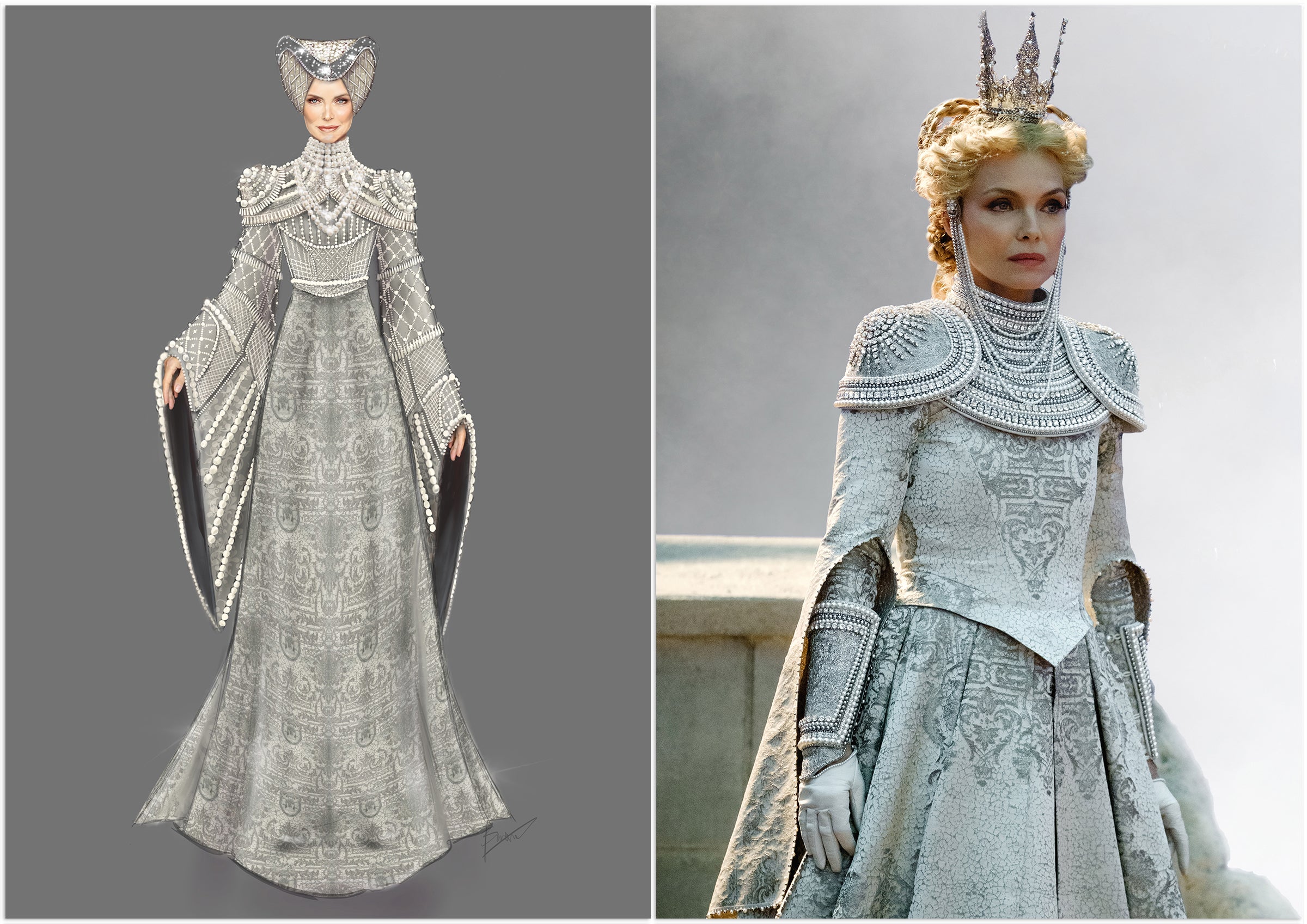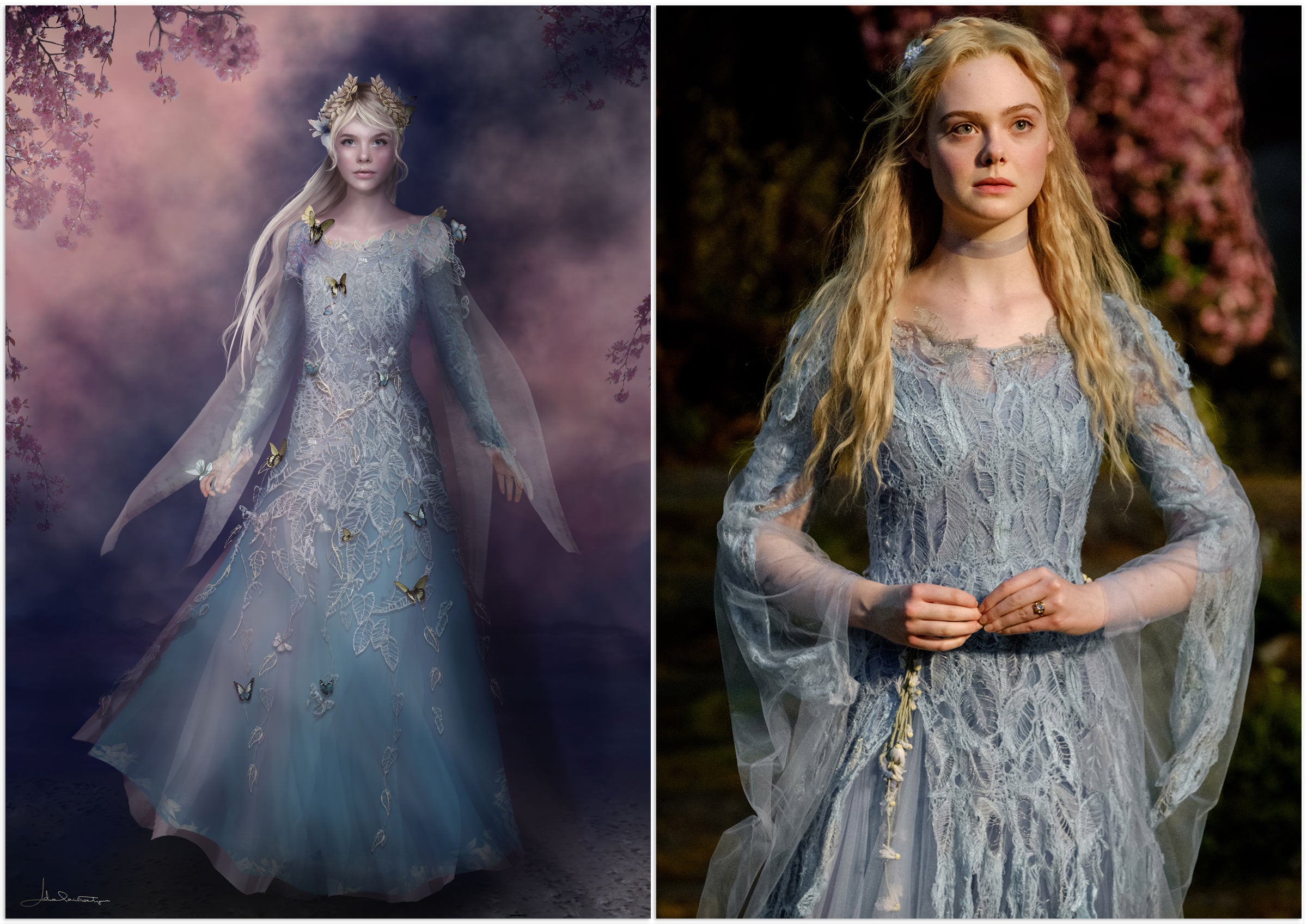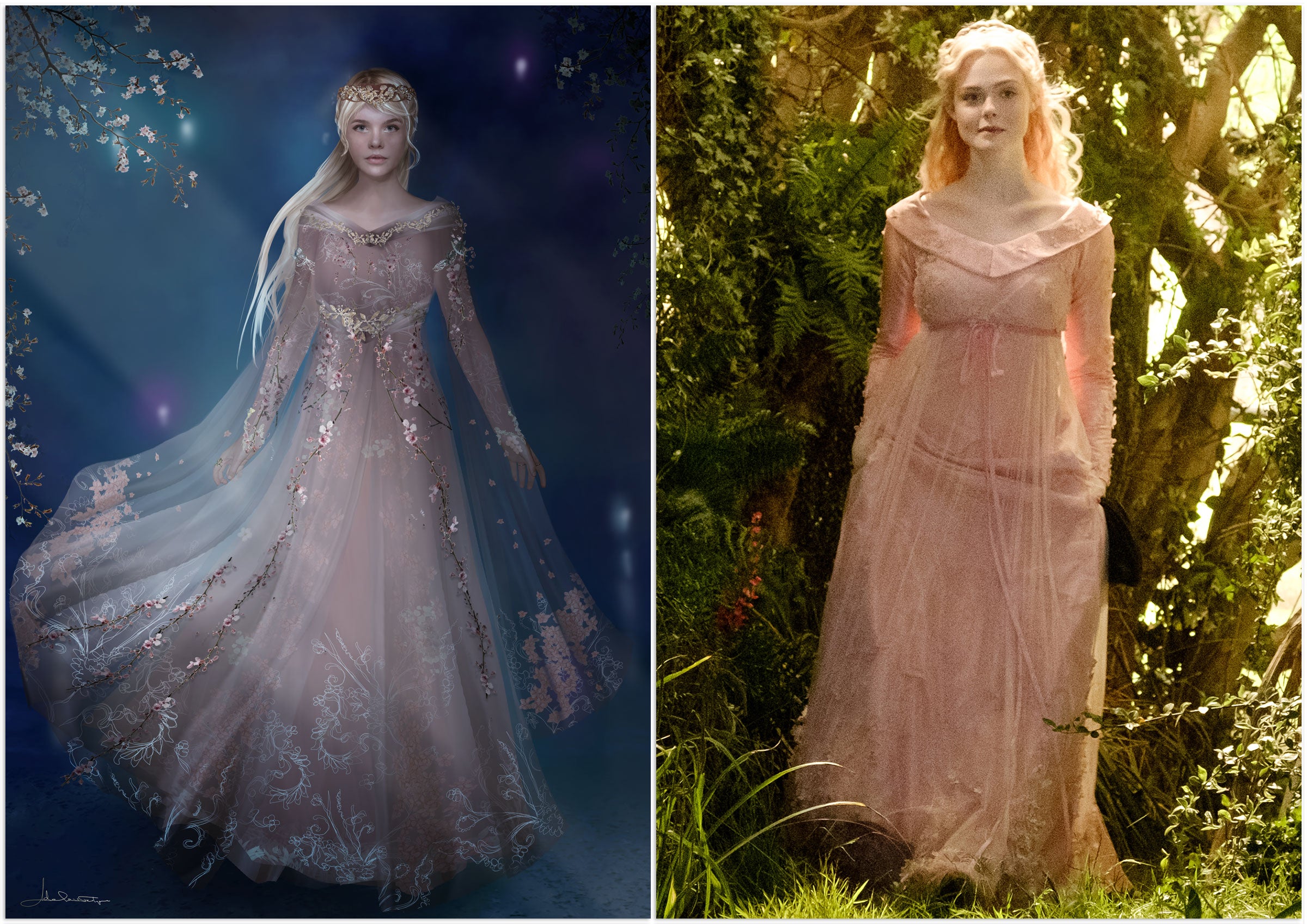All of the Easter eggs and hidden details in Angelina Jolie, Michelle Pfeiffer and Elle Fanning's costumes.
Every time Michelle Pfeiffer's Queen Ingrith appears onscreen in Maleficent: Mistress of Evil, she is somehow wearing more luxurious fur capes, dripping in even more pearls, ornamented with even sparklier jewels. Sitting in the theater, I found myself gasping at the sight of her, taken aback at the glamour of it all each time she entered a scene.
"But did you like the movie?" costume designer Ellen Mirojnick laughs when I've finished raving about her work. I tell her I did. Mistress of Evil, Disney's sequel to 2014's Maleficent, picks up five years after that once-upon-a-time, as the formerly sleeping beauty, Aurora (Elle Fanning), is engaged to Prince Phillip (Harris Dickinson). Their nuptials promise to unite their two kingdom, if only their soon-to-be-in-laws -- chiefly, Aurora's godmother, Maleficent, the misunderstood sorceress played by Angelina Jolie, and Phillip's mother, Ingrith -- could get along. Alas, war is waged, both in manners (watching Jolie and Pfeiffer swap increasingly barbed digs during a dinner party is worth the price of admission alone) and eventually actual warfare of the medieval knights and CGI faeries variety.
Director Joachim Rønning (Pirates of the Caribbean: Dead Men Tell No Tales) assumes the reigns for the sequel, while Mirojnick takes over for Anna B. Sheppard, who earned an Oscar nomination for her work on the first film. That Mistress of Evil picks back up so many years after that first happily-ever-after gave Mirojnick the creative freedom to put her own stamp on the fairy tale.
"The thing that enticed me was that it had not been made, like, the next year. So Aurora had grown up and Maleficent now has wings," she explained. "And then there was a new group that Maleficent finds, the Fey, and there was this introduction to a queen who has built a kingdom as big as Versailles. There are many different levels of telling yet another chapter in this story while trying to maintain the brand at the same time. It was a great challenge on all fronts."
Ahead of Maleficent: Mistress of Evil's release, Mirojnick provided ET with an exclusive look at her design sketches (below) and discussed the process of outfitting her leading ladies and the details hidden in their costumes.
Angelina Jolie as Maleficent

ET: There are all these new components, but in terms of designing for Maleficent, having had that design language established in the first movie, how do you come in and make it your own?
First and foremost, she has evolved, because she has wings. In the first one, she didn't have wings -- her wings, as we learned, were cut off when she was young -- so that was the first thing that has to be taken into consideration. We had to shift the silhouette because the fabrications that needed be used to allow Maleficent to fly really beautifully and gracefully were way different from the first film, where they were heavier fabrics, lush fabrics that were far more beautifully integrated into the land. She was a character that stood on her feet. Now, she was able to fly, and so we introduced silks and chiffons and Georgettes in all different layers to give her a fluidity in flight, to have it almost be like a ballet, and still maintain the language of Maleficent and how she has been established in real time and as a result of the animation prior.
Angelina really owns this character. And you've worked with her before, both as an actor and a director. Does she come in with ideas of where she wanted Maleficent's costumes to go in this film?
Oh, absolutely! Angie is such an amazing actor, producer, director to work with, because she is totally focused on the totality of the film, number one, and then, of course, her character and how it fits within the story as the story unfolds and where her story arc will go. In the very beginning, we covered many, many, many, many different arenas -- because of the amount of different types of situations that not only Maleficent would find herself in, but the rest of the film reveals -- and yes, she does come in with very, very strong ideas. With that, it's our job to translate it into a language, to begin with, and then collaborate further and further and further on.
Her most striking ensemble, for me, is what she wears to the engagement dinner, with the gold-dipped crow skulls as her collar and the skull-accented headdress. What was the genesis of that costume?
It was for an engagement dinner and she is the queen. And she, under no circumstances, was going to be intimidated. This is her formal, queen robes and it is just the heightened version of who Maleficent is, make no bones about it -- that's not intended to be a pun! [Laughs] She is there to represent her kingdom, her family and she needed to hold a very strong stance. She comes to the royal dinner as the queen, and this is who she is, this is the strength of who she is, and she's going queen-to-queen. She is the queen of the land, make no mistake about it.
There's not much, if any, purple used in Maleficent's costumes in either film -- which is, of course, her signature color in Sleeping Beauty. Did you ever try your hand at introducing more purple into her look?
It actually is used, but you would never actually see it for the exactness of that color! In her costume, particularly the black of that costume, there are about three or four layers of fabric to make up that costume from inside out. There are different tones of black that are used to create that blackness and one of them is a blackish-purple, but that was our biggest attempt to use purple, to be honest. But we did try! [Laughs] We did try to use it. Angie's very, very, very big note at the beginning of the process was that she felt that Maleficent was very black and white, very graphic, as if she were a screen star from the black-and-white films of yesteryear. It was a very strong black-and-white image. Just as they did in films prior, there's many colors that you do use to create a black-and-white feel, so that was our way into using a tone of purple in the black.
Michelle Pfeiffer as Queen Ingrith

Queen Michelle is finally playing a queen. And, my god, the outfits you have her in are dripping with pearls and diamonds. She is not the type of gal that looks in the mirror and takes one accessory off.
No, Coco would maybe have a palpitation in seeing that, right? [Laughs]
It's all very intricate. Would you say Michelle's were the more involved costumes of the bunch? Or that took the most time to create?
I'm glad that it looks that way but it didn't necessarily take twice as long to create. The vision for Queen Ingrith was very clear from the very beginning. Michelle had not been cast at that time, but the idea of who Queen Ingrith was and what she appeared like -- in this very, very luxurious way, having very, very luxurious pieces in her wardrobe -- it was not to tell you that she was evil from the get-go. It was really to give you a sense of, This is a woman who gets what she wants and has great purpose and will stop at nothing to get what she wants. You're not quite certain if it's for evil intentions or not evil intentions, but that was the overall theme. And then when they cast Michelle, everything was adapted for her and because her coloring was so sensational, the pearls and the diamonds were the perfect color accents to making a platinum queen absolutely gorgeous.

I never thought the designs read as evil. More so, I thought they looked like armor. Like a helmet and breastplate made of jewels. And they look heavy! How heavy are those pieces?
They're not! But if you look at any armor, armor looks heavy as well. So they look heavy. They look like they are armor. The fabric itself, it's Italian and it was chosen because it looked like it could have metal in it, but it doesn't. The pieces themselves were created on a base that was so flexible -- I can't tell you exactly what it was because it is a fabrication that is just used to create bases of things to hold other things on -- but it wasn't heavy and we worked it out very, very carefully so that Michelle could move in it. The point that was more difficult to figure out was how were the shoulder pieces going to work with the breast piece? And how was she going to maintain flexibility and do whatever she needed to do? But it wasn't heavy at all.
I loved that with her final look (above), I just thought, "Of course, this woman would wear white on her future daughter-in-law's wedding day."
[Laughs] Of course. Of course! What else would it be? I think that Michelle does an evil look better than I've seen in a long time. She is par excellence as Queen Ingrith and having her evil ways, but she wears it better than anybody I have ever seen wear it.
Elle Fanning as Aurora

As you mentioned, five years have passed and Aurora's style has certainly evolved. Her costumes feel more mature, while also being more lacey and whimsical.
When she's introduced, she's now queen of the Moors -- Maleficent appointed her Queen of the Moors -- and she lives in this land with all the different fairies that she cares for and watches over. The dress was made to feel as if it was made by the fairies. It was not a structured, court-like dress. It was a very whimsical, fairy-tale dress that only the fairies could create. That was the reason she was introduced in the blue. It is a totally silk-embroidered, organic design. It is all handmade. It has no machine-making in it at all.
The character has those iconic dresses in Sleeping Beauty -- the blue and pink gowns -- and it feels like you're paying homage to those here, both in that first dress (above) and the pink, floral one she wears for the royal dinner (below).
Yes, they were definitely homages to the animation and homages to Sleeping Beauty. The dress that she wears to the engagement dinner has the same feel -- with embroidered flowers over net -- [but] it's the 60th commemorative year of Sleeping Beauty, so what we did is -- although it wasn't really good to do a dress at that time that was a version of the Sleeping Beauty dress -- we adapted just the collar for that ensemble. Later on in the film, at the very, very, very end, I did a new version of the Sleeping Beauty dress for her, after she marries the prince when they're at the castle waving bye-bye to Maleficent. So using that Sleeping Beauty scene and Aurora, Queen of the Moors, we kind of blended it all to become a fairy tale and that she's a fairy-tale princess/queen.

When you look at all the costumes you designed, is there a hidden detail that you really appreciate? Or a nod to the animation that you've put in that you're particularly proud of?
I think it's adapting the Sleeping Beauty collar and the Sleeping Beauty feel for Aurora. It might not be obvious when she walks into dinner -- and then the dress goes through an evolution -- but to view Sleeping Beauty as the next evolution of Aurora was-- I hope it worked and I hope it didn't look goofy and I hope that it actually was part of her story that could then go on. It's not hidden. It's right there out in plain sight, but I'm very happy that we were able to pay homage to that.

RELATED CONTENT:
